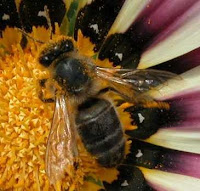 |
| The Mayflower, Google Image |
The honey bee arrived in America from Europe only around 1620. Like cows , they were not native to North America. As European colonists arrived to the New World, they brought with them an agrarian way of life inherited from Greek and Roman philosophers, thus bringing beekeeping skills among others.
"By 1621, the Virginia Company was sending ships loaded: "with divers sorte of seed, and fruit trees, as also Pidgeons, connies (rabbits), Peacok masstiffs, and Beehives,"" (Bees in America, T. Horn).
However, there are more than 4,000 native bee species in the United States, that were present when the imported honey bee appeared. It is believed that the European dark bee (Apis mellifera mellifera) was domesticated in modern times, and taken to North America in colonial times.
 |
| German or Black Bee. http://aramel.free.fr/INSECTES18terter.shtml |
These small, dark-colored honey bees are sometimes called the German black bee, although they occurred originally from Britain to eastern Central Europe (Wikipedia). These bees swarmed, and evolved along the centuries adapting themselves to their new environment. Later, Italian , Carniolan and Caucasian bees were imported. The Italian honey bee was and still is the most popular bee because of her gentleness and her abundant amount of honey crop produced each year. These too adapted themselves to a new world, and climate thriving until recently with the "discovery" of new viruses, mites, pathogens, pesticides and finally the phenomenon called CCD, Colony Collapse Disorder a combination of many factors.
After two seasons with Italian bees, and our adventures raising them in Minnesota where the climate is harsh, with long Winters and almost non existent Springs and rather short Summers. In addition to the Varroa mites that can decimate a colony in one season. I have decided to buy a colony of Russian honeybees. My husband and I will be installing them on a private, prairie restored land in Chanhassen in late April.
Why? Because I came to the conclusion that maybe the Italian honeybee is not the best one for my region; it is however the most popular and the one highly recommended for beginners but maybe not the best.
Russian bees do not "explode" in population as soon as the weather is favorable like the Italians do. They will wait to rear a brood until pollen and nectar are available, following their environment; thus needing less "human" feeding.
Russian bees are also well adapted to survive harsh winters, coming from the far-eastern Russia, a place called the Primorski region on the Sea of Japan, and have coexisted for the last 150 years with Varroa mites, thus genetically resistant to the might mites. Finally, they produce as much honey as their counterparts from Italy. I will let you know later, how this "new" honeybee hitch a hike to America!
 |
www.ars.usda.gov
Experimental yard in Khorol, Primorsky ~ 200 Km NW of Valdivostok |
Don't get me wrong I still love my Italian bees, how could I not? They are beautiful!
 |
| Our Italian bees hanging on! |
 |
| Our Italian bees being happy! |






No comments:
Post a Comment